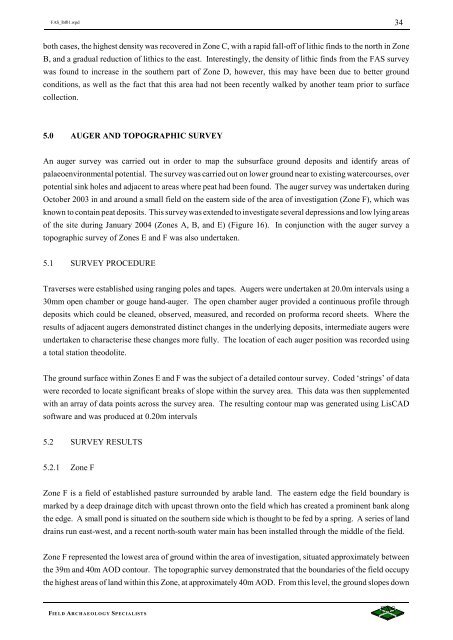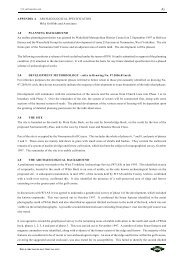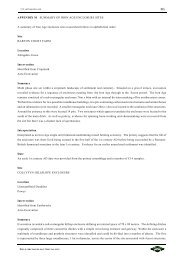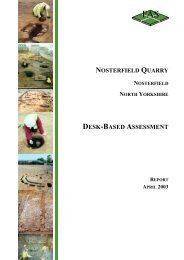ARCHAEOLOGICAL EVALUATION - Mike Griffiths and Associates
ARCHAEOLOGICAL EVALUATION - Mike Griffiths and Associates
ARCHAEOLOGICAL EVALUATION - Mike Griffiths and Associates
Create successful ePaper yourself
Turn your PDF publications into a flip-book with our unique Google optimized e-Paper software.
FAS_lbf01.wpd 34<br />
both cases, the highest density was recovered in Zone C, with a rapid fall-off of lithic finds to the north in Zone<br />
B, <strong>and</strong> a gradual reduction of lithics to the east. Interestingly, the density of lithic finds from the FAS survey<br />
was found to increase in the southern part of Zone D, however, this may have been due to better ground<br />
conditions, as well as the fact that this area had not been recently walked by another team prior to surface<br />
collection.<br />
5.0 AUGER AND TOPOGRAPHIC SURVEY<br />
An auger survey was carried out in order to map the subsurface ground deposits <strong>and</strong> identify areas of<br />
palaeoenvironmental potential. The survey was carried out on lower ground near to existing watercourses, over<br />
potential sink holes <strong>and</strong> adjacent to areas where peat had been found. The auger survey was undertaken during<br />
October 2003 in <strong>and</strong> around a small field on the eastern side of the area of investigation (Zone F), which was<br />
known to contain peat deposits. This survey was extended to investigate several depressions <strong>and</strong> low lying areas<br />
of the site during January 2004 (Zones A, B, <strong>and</strong> E) (Figure 16). In conjunction with the auger survey a<br />
topographic survey of Zones E <strong>and</strong> F was also undertaken.<br />
5.1 SURVEY PROCEDURE<br />
Traverses were established using ranging poles <strong>and</strong> tapes. Augers were undertaken at 20.0m intervals using a<br />
30mm open chamber or gouge h<strong>and</strong>-auger. The open chamber auger provided a continuous profile through<br />
deposits which could be cleaned, observed, measured, <strong>and</strong> recorded on proforma record sheets. Where the<br />
results of adjacent augers demonstrated distinct changes in the underlying deposits, intermediate augers were<br />
undertaken to characterise these changes more fully. The location of each auger position was recorded using<br />
a total station theodolite.<br />
The ground surface within Zones E <strong>and</strong> F was the subject of a detailed contour survey. Coded ‘strings’ of data<br />
were recorded to locate significant breaks of slope within the survey area. This data was then supplemented<br />
with an array of data points across the survey area. The resulting contour map was generated using LisCAD<br />
software <strong>and</strong> was produced at 0.20m intervals<br />
5.2 SURVEY RESULTS<br />
5.2.1 Zone F<br />
Zone F is a field of established pasture surrounded by arable l<strong>and</strong>. The eastern edge the field boundary is<br />
marked by a deep drainage ditch with upcast thrown onto the field which has created a prominent bank along<br />
the edge. A small pond is situated on the southern side which is thought to be fed by a spring. A series of l<strong>and</strong><br />
drains run east-west, <strong>and</strong> a recent north-south water main has been installed through the middle of the field.<br />
Zone F represented the lowest area of ground within the area of investigation, situated approximately between<br />
the 39m <strong>and</strong> 40m AOD contour. The topographic survey demonstrated that the boundaries of the field occupy<br />
the highest areas of l<strong>and</strong> within this Zone, at approximately 40m AOD. From this level, the ground slopes down<br />
FIELD ARCHAEOLOGY SPECIALISTS







